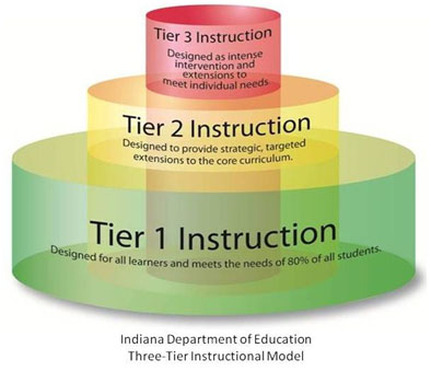Definition
Tiered instruction is a form of differentiation which allows each student to excel at their own level of complexity while focusing on the same essential understandings. It allows students to work in their own Zones of Proximal Development.
Zone of Proximal Development: "the distance between the actual developmental level as determined by independent problem solving and the level of potential development as determined through problem solving under adult guidance, or in collaboration with more capable peers" Vygotsky
Tiered instruction is a form of differentiation which allows each student to excel at their own level of complexity while focusing on the same essential understandings. It allows students to work in their own Zones of Proximal Development.
Zone of Proximal Development: "the distance between the actual developmental level as determined by independent problem solving and the level of potential development as determined through problem solving under adult guidance, or in collaboration with more capable peers" Vygotsky

Tiered Levels
There are many ways you can tier an assignment...
By way of: Task
- from basic to advanced Process
- from simple to complex or
Product
- from verbal/linguistic to kinesthetic
There are many ways you can tier an assignment...
By way of: Task
- from basic to advanced Process
- from simple to complex or
Product
- from verbal/linguistic to kinesthetic
When to use tired instruction
Tiered instruction can be used whenever you want, however it is important to consider the following
• Would tiering the activity challenge the students or merely complicate the assignment?
• Are you making the advanced level work more complex, or are you merely adding more work?
• Do you have a fair way to assess?
• Can you create an intriguing activity for each level?
How to implement it
1. Choose an SLO that students should know or understand and choose whether to tier according to readiness, interest, or learning
profile.
2. Pre-assess student's profile, readiness, and/or interest.
3. Create an activity or project that is clearly focused on the concept.
4. Adjust the activity to provide different levels of difficulty.
5. Match students to appropriate tiered assignment.
The Presentation below, provided by SlideShare, is a great step by step application of tiered instruction for teachers!
Tiered instruction can be used whenever you want, however it is important to consider the following
• Would tiering the activity challenge the students or merely complicate the assignment?
• Are you making the advanced level work more complex, or are you merely adding more work?
• Do you have a fair way to assess?
• Can you create an intriguing activity for each level?
How to implement it
1. Choose an SLO that students should know or understand and choose whether to tier according to readiness, interest, or learning
profile.
2. Pre-assess student's profile, readiness, and/or interest.
3. Create an activity or project that is clearly focused on the concept.
4. Adjust the activity to provide different levels of difficulty.
5. Match students to appropriate tiered assignment.
The Presentation below, provided by SlideShare, is a great step by step application of tiered instruction for teachers!
Benefits of Tiered Instructions
- Attends to different learning styles, needs, levels, and intelligences.
- Each student is appropriately challenged.
- Promotes a growth mindset in the students.
- Focuses on the concept rather than learning differences.
*The button below will take you to a fantastic resource with lesson plans for tiered instruction in multiple subjects and grades. It also references some books by differentiated instruction specialist, Carol Ann Tomlinson.
References
Kingore, B. (2006). Tiered instruction: Beginning the process. Retrieved from http://www.bertiekingore.com/tieredinstruct.htm
Learn Alberta. (2005). Differentiated Instruction. Retrieved from http://www.learnalberta.ca/content/kes/pdf/or_ws_tea_elem_02_diffinst.pdf
Miller, A. (2012) Six strategies for differentiated instruction in project-based learning. Retrieved from http://www.edutopia.org/blog/differentiated-instruction-
strategies-pbl-andrew-miller
Sousa, D.A. & Tomlinson C.A. (2011). Differentiation and the brain. Bloomington IN: Solution Tree Press.
Tice, C. (2008). Differentiated instruction: Tiered instruction. Retrieved from http://iss.gstboces.org/ctice/trainings/di/strategies/tiered.htm
Kingore, B. (2006). Tiered instruction: Beginning the process. Retrieved from http://www.bertiekingore.com/tieredinstruct.htm
Learn Alberta. (2005). Differentiated Instruction. Retrieved from http://www.learnalberta.ca/content/kes/pdf/or_ws_tea_elem_02_diffinst.pdf
Miller, A. (2012) Six strategies for differentiated instruction in project-based learning. Retrieved from http://www.edutopia.org/blog/differentiated-instruction-
strategies-pbl-andrew-miller
Sousa, D.A. & Tomlinson C.A. (2011). Differentiation and the brain. Bloomington IN: Solution Tree Press.
Tice, C. (2008). Differentiated instruction: Tiered instruction. Retrieved from http://iss.gstboces.org/ctice/trainings/di/strategies/tiered.htm
